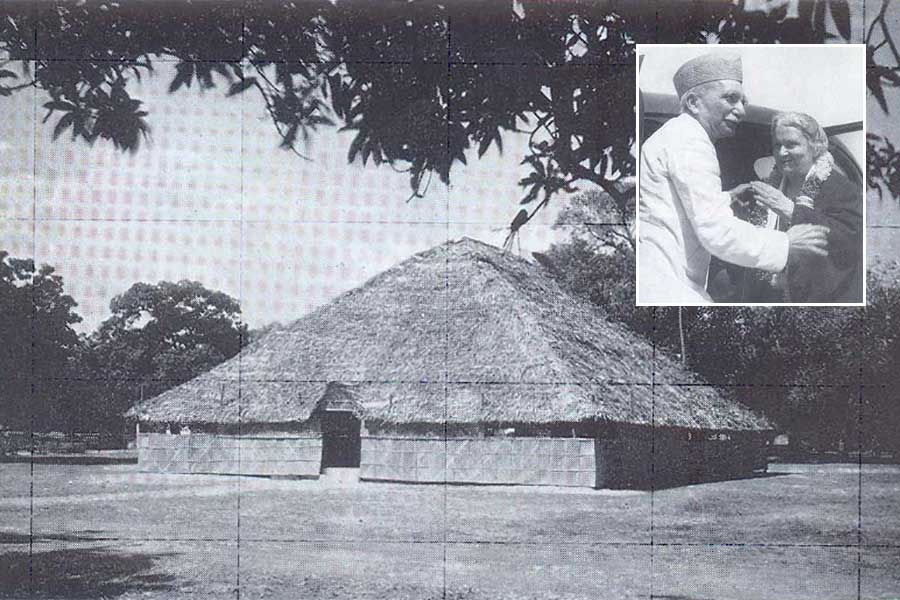Dr. Montessori arrived in India in 1939. This account of her sojourn in India aims to put her contribution to education in India in the context of the tumultuous decade, and put it into perspective in terms of the creation of nation.
Early childhood education in India at the turn of the century was largely modeled by the missionaries in the kindergarten programme they offered. However alternatives were being sought in a country that was seeking a redefinition of itself. Tagore’s philosophy of the education of the spirit in closeness to nature without any barriers between teachers and students, had begun to make an impact on those who were beginning to realise that education of the young was a key to freedom of the nation.
Montessori education made an early entry into India, long before Dr. Montessori visited the country. There were Indians were among the devoted students in the earliest training courses that Dr. Montessori gave in Rome in 1913. It was in Gujarat that there was the first glimmering of interest. Mahatma Gandhi mentions a visit to a Montessori school in India as early as 1915 in Amreli, in Saurashtra.
The Sarabhais a well-known business family of Ahmedabad, made an early and lasting contact with Montessori education. Sarla Devi Sarabhai, a young mother, came across a book written by Dr. Montessori and was inspired by the philosophy. Raising her own children (eight of them including the eminent scientist Vikram Sarabhai) she diligently studied Dr. Montessori’s work acquiring the early publications of The Secret of Childhood and The Montessori Method. Her interest was supported by her husband Ambalal Sarabhai. On a visit to England the Sarabhais met E. M. Standing who had studied the Montessori method in Italy, and was her staunch supporter, and invited him to come to India. In 1922, E. M. Standing came to Ahmedabad as the guest of the Sarabhais.
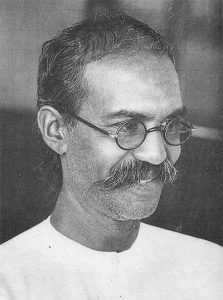
Gijiubhai Badheka
Gijiubhai Badheka, read of Montessori’s ideas and this had a huge impact on his life. Gijubhai’s son was ready for school in 1913 and this led Gijubhai to see the child education classes conducted under the guidance of Motibhai Amin at Vaso, Gujarat, and he was gifted a Gujarati book describing the Montessori method of education which convinced him about the need to the begin at the very beginning, In 1916 he left legal practice and entered into education full time, and the Dakshinamurti Balmandir, a pre-primary school, came into being August 1920. Gijubhai’s contribution was the evolution of a system of child education suitable to Indian environment, training teachers and creation of suitable literature for children, teachers and parents. The educational philosophy of Montessori, was oriented towards Indian conditions. Freedom and love were the twin principles around which the pedagogy revolved. With the introduction of equipment for sensory development, coupled with the use of music, dance, travel, story-telling and play-ground as instantly acquired popularity with children and parents. In 1924 he established the Dakshinamurti Training College in Bhavnagar. Some Montessori materials were made in a local workshop and the children flourished in a culturally appropriate setting.

Tara bai Modak
Gijubhai found a collaborator with an equal passion for the education of young children – Tara bai Modak. Tara bai, a single mother, was deeply committed to the social cause of freedom and justice for the country and for women. She shifted her base to Bhavnagar to work alongside Gijubhai. In 1925 they started editing a Gujarati monthly, the Shikshan Patrika, and their frank and fearless criticism of the existing methods of education created a sensation in Gujarat. For the propagation of the new system of child education among the masses, conferences were organised in 1925 at Bhavnagar and in 1928 at Ahmedabad. The duo also founded the Indian Montessori Society of which they were joint secretaries. In a report on the first three years of activity of this society which was published in 1929 in which they highlighted the need for trained teachers, the need for material and the practicalities of taking this method into remote villages. Tara bai went on to found a school based on Montessori lines called Shishu Vihar in Dadar, Mumbai. She founded Nutan Balashikshan Sangh a training course for teachers in 1938. Tara bai’s work also included parent education, a pioneering effort, at a time in our history in which schooling was not important. She tried to help parents understand the scientific base of preschool education.
Interest in Montessori education also came from the growing Theosophical movement. George Arundale, an Englishman, came to India in 1918 to support Annie Besant and the Home Rule movement. He worked alongside Dr. Besant and believed like her that education was the only way to win freedom and regain an Indian national identity. Arundale collaborated with Besant in several educational efforts and served as the Principal at Besant’s Central Hindu College in Benaras. The two of them co-founded the Indian Boy Scouts movement. Dr. Arundale controversially married the 16-year-old Rukmini Devi the daughter of a South Indian Theosophist. In Madras, the couple worked with Dr. Besant and imbibed from her the ideal of an education without fear. In 1933 when Dr. Besant died they decided to open a school in her honour. Dr. Arundale who succeeded Dr. Besant as the president of the Theosophical Society believed that education had to be made compulsory, and would have to be put back in Indian hands. Indian teachers in Indian schools he believed would need to teach Indian languages, culture and history ‘India refuses to be an educational dependency of Great Britain and any longer.’ Yet no educational work would be complete without a training centre for teachers. Education of children depended upon the right type of teacher. In 1937 the Arundales met Dr. Montessori in Holland and invited her to come to India. It was initially decided that Dr. Montessori would come to India in October 1939 and would stay in the country for six months. It was also decided that she would study the Indian conditions and relate her educational system to the needs of the Indian child.
In 1939, Chakravarti Rajagopalachari, best known as Rajaji, was the Premier of Madras. He knew about Maria Montessori and her method, and regarded her visit to his city was an event to be welcomed. The society geared up for the momentous arrival.
Even a workshop to prepare Montessori material according to specifications was created. She would have full access and use of the school, and she would lecture on a platform of flagstones under the thatched roof constructed in lieu of a lecture hall.
As the advertisements about her arrival and the training course that was to be held in the Theosophical Society were sent out the war broke out in September 1939. Many people were afraid that this would jeopardise Montessori’s coming. Dr. Arundale gave reassurances to all through his writing in The Theosophist.
We have every reason to believe that Madame Montessori, warrior as she is, will come despite the difficulties, she has indicated her desire to come if possible, and the local Government interposes no objection to her coming. There will be a record attendance of students, so that we shall indeed be a large number around about Christmas.
Vol 61, Part I, November 1939 – On the Watch Tower
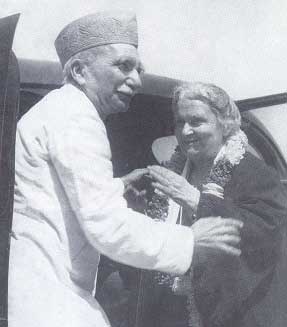
On her way to India Dr. Montessori is warmly received at the airport in Karachi by the Mayor, Mr. Jamshed Nusserwanji
Dr. Montessori arrived in Madras in November 1939. She arrived in the Tata mail plane. Dr. Montessori travelled by air from Naples. In Karachi where they changed from a plane of the Royal Dutch Airlines to one of the Imperial airways, they were officially received by the Mayor of Karachi and other authorities of the town. She was piloted by none other than JRD Tata. It was a small plane with just five or six seats only. It was a six hour journey from Bombay to Madras. Flying was very uncommon, and train journeys were still the norm. In fact, some, like Ms. Gool Minwalla, travelled for three and a half days, all the way from Karachi to attend the course. Dr. Montessori and Mario received a grand welcome on arrival.
She was then housed in Olcott Gardens bungalow on the first floor. Students had arrived from all parts of the country and had been accommodated in palm leaf apartments. They students gathered in the semi open lecture hall.
The course was inaugurated on November 11, 1939. Dr. G. S. Arundale, President of the Theosophical Society and honorary member of the AMI was a gracious host. Dr. Montessori was given an official welcome by the Mayor of Madras, the Vice-Chancellor of the Madras University, the President of the South Indian Teachers’ Union. Mr. S. Satyamurti and Chakravarthi Rajagopalachari also attended the special event.
There were more than 300 students from all parts of India, Burma and Ceylon, and even one from Zanzibar in East Africa. Five states that had introduced the method in their schools sent official delegates. The Catholic Missions sent students. Dr. Arundale addressed the gathering.
“Friends, it gives me the very greatest pleasures as President of the Theosophical Society to welcome to our platform at this convention our very distinguished and world renowned guest, Dr. Maria Montessori. I feel sure you are all of you very happy to see her here and are looking forward with the deepest interest to that exposition of the Science of Education which she alone in the world can give. We welcome also Mr. Montessori who though not so evident in the foreground, is almost indispensable to Madame Montessori and upon whom she relies so much and who is so wonderfully conversant with Madame Montessori’s system of education.
We are very thankful to have her here because we believe her presence here is harbinger of the future of education in this country. True greatness knows no distinction of a country or race or faith, and the tremendous work that Madame Montessori has been able to do in the west will be more than equaled by the tremendous work I feel sure she will do in the East. I am most happy to feel that there is some likelihood of Madame Montessori’s co-operation with our own educational work to strengthen it in every possible way, so as to enable us the more effectively to serve India and the East generally.
There are no details of the plans we may be able to adumbrate, but I feel sure that we shall work together under her great inspiration and I am more thankful that it has fallen in the privilege of our society to be the first to give her the warmest and most grateful of welcome.
I now call Madame Montessori to speak to us. She will speak in that very beautiful language Italian and it will be translated in English, by Mr. Montessori. I can assure that if you had only the Italian that would be quite enough. You would gain from the rhythm, the music and the beauty of that language all that you would need. But owing to the human frailty and our lack of understanding of that language, it will be translated in English. ”
The Theosophist issue of March 1940, includes an account of the speech given in December 1939, during the course inauguration by Dr. Arundale and Dr. Montessori.
All the speakers, at the inauguration, unanimously agreed that Dr Montessori’s visit to India was a very important fact in Indian educational history and would certainly have far-reaching consequences. They also stressed her personal courage and deep love of childhood and humanity which had urged her to undertake this far journey notwithstanding the extremely difficult circumstances of the moment.
After Dr. Arundale’s warm welcome, Dr. Montessori stepped up to address the eager audience. She spoke in Italian while Mario translated for her, the first of many such speeches in India which they would do this way together.
“I feel as I stand facing you that this is one of the greatest moments in my life. For many decades of years the child has helped and revealed to me something which lay in the depths of its soul. And my work has been the work of a follower, a follower who has discovered something and followed that lead, followed that something which had been discovered in the soul of the child.
But how much lack of comprehension, how much misunderstanding, have I not met in so many countries, because the people thought I was talking about a method of education, while I was speaking of a revelation given to me by the soul. But here among you all I feel that there is a very deep and clear understanding, because the awakened spirit and soul is necessary in order to be able to enter into the spirit, the soul. That is why I say it was a great event in my life to have been called here and to have had the privilege to be able to teach a great group of your citizens. It will be my greatest wish to be able to remain here among you and to have your collaboration. I say very frankly and honestly that I do not work for India but that I work with the Indians. I wish to work with the Indians, so that a great centre may be founded here which may have influence upon the rest of the world. India first (in English).
It would be difficult in a few minutes to illustrate the work of my life, and even if I did, I would not be developing the theme that I have given, because I said that I would speak of the Child Messiah. The Messiah is a teacher. Therefore, I will not talk about a method of educating children, but about something which has been revealed by children, which had come forth from the Child’s soul. In order to give a clear idea of what I think, I shall make a short reflection.
Let us look upon the child as our collaborator. He has one part of the task, we another. His task is to furnish us with first detachment, the first light of pure love. Human society cannot be changed unless both adult and children collaborate. It is necessary to take this treasure and to cultivate it. To cultivate it is not easy, and that is the task of education. But in true education, in real education, not only is there the child who is educated but also the adult undergoes transmutation.”
The Theosophist issue of March 1940, includes an account of the speech given in December 1939, during the course inauguration by Dr. Arundale and Dr. Montessori.
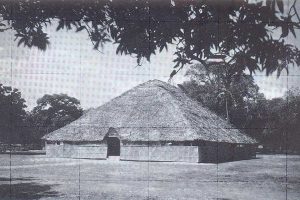
Theosophical Society, Adyar
The course was held in the compound of the Theosophical Society, Adyar. As there was no building large enough to accommodate all the students, palm leaf huts were built, the largest of which served as the lecture hall.
A dais of flagstones was built for Dr. Montessori’s table. The inauguration of the Course was attended by the leading personalities of Madras, among them C. Rajagopalachari and S. Satyamurti. Students came from all over India and Sri Lanka to attend this course, which involved three months of intensive work. The students lived in the compound of the Theosophical Society.
It was a residential course. Lecture times were rarely fixed and lectures were given at all hours of the day from early morning till late evening. The students lived close to the Montessoris and learned from them with reverence. This first course took place from late December 1939 till February 1940.
Dr. Montessori lectured in Italian. These lectures were translated into English by Mario Sr., who, from all accounts, was a jolly person and was Dr. Montessori’s companion, friend and helper, and kept her in good spirits. Dr. Montessori lectured in low tones. When she spoke, the students maintained attentive silence. The translation done after every few lines gave the students a few moments to assimilate what was said. Dr. Montessori paid very close attention to the translation.
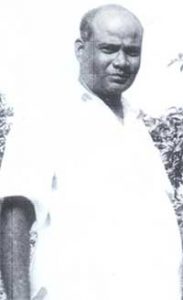
Mr. Gundu Mani
Mr. Gundu Mani, who worked at the Theosophical Society lived in Urur village with his daughter who attended the first course. As he knew shorthand and was also a typist and he was asked to take down everything that Dr. Montessori spoke. He would tell sit close to the dias and call out “Slow, slow!” Dr. Montessori would smile at him and say “I have to speak and Mario has to translate, so you should have plenty of time!” Mr. Gundu Mani would type out all the notes for the lecture that was held the same day and then the galleys would be sent every night to Vasantha Press, in Adyar. The notes were distributed to the students the next day.
Those who knew Dr. Montessori at the time reiterate the fact that her approach to the child was scientific. If children were handed to her she would never cuddle them close but get the parents to set them on the floor, observing their behaviour with great attention.
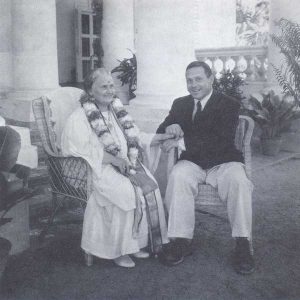
Mr. Montessori liberated from internment. The reunion on Dr. Montessori’s 70th birthday.
Mario helped not only with the translation during Dr. Montessori lectures but he also took a great deal of interest in the work done by the students of the course with the material. He would work with them often demonstrating the correct use of the materials. A lot of his time was spent with the children at the Besant Memorial School. A lot of the foundational material of cosmic education which was already being developed came to fruition here.
In due course the police curtailed the movement of the Montessoris in Chennai. Even though they were enemy aliens on British soil they were highly regarded. After Mario returned from jail to spend Dr. Montessori’s birthday with her with the special consideration of the British officials they were held in Kodaikanal. Living in a beautiful cottage called Rose Banks overlooking the lake the Montessoris spent their time in the best way possible training teachers, lecturing and giving courses. Despite the war some wonderful people did the course at that time coming from all over India and even from Ceylon to make it happen. It is believed that a Pakistani professor of Botany collaborated with Mario in developing the content of the biology classifications for children between 6-12. With the lush green growth of the trees around them Kodaikanal was an ideal environment.
Maria Montessori was called mammolina and she appreciated the fertile minds and sensitive spirits of the company in which she found herself. C. S. Trilokekar, Sankara Menon, Kamala Trilokekar, Dr. Padmasini, who were all associated in various capacities with the Theosophical work and the work of education in Besant school, found their own educational philosophy completely compatible with the ideas set out in the Montessori training.
Norma Sastri, Rukmini Devi’s sister-in-law and a resident of the Theosophical Soceity was a friend and associate of the Montessoris. She deeply imbibed the ideas although she never formally took the training. For a while, she served as the governess in the home of the Maharaja of Gwalior and took responsibility for the education of the children. A gift was given to the young princes of the family – a simple broom! Imagine the shock of the royal household! The Montessori approach is rooted in self reliance and in the importance of the care of the environment. So for Norma, this was an ideal gift representing an adult’s action to offer freedom.
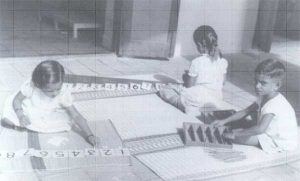 Dr. Montessori returned to Europe after the war. Yet India called to her once again. She returned to do another course in the Theosophical Society in Chennai. It was hoped at this time of Indian independence a University for Montessori would be established in India. The Government of Travancore sponsored the Montessori course held in India 1947 and also deputed teachers from Kerala to be trained. In 1948 the Montessoris left Madras to run a course in Ahmedabad. The lectures she gave on this course were published as the seminal work of the century of the child that she had ushered in – The Absorbent Mind. The Indian wing of the Association Montessori Internationale was founded the same year with Sarla Devi Sarabhai at its helm. Due to the partition of India and Pakistan and the tragic events that followed the planned University never came to be.
Dr. Montessori returned to Europe after the war. Yet India called to her once again. She returned to do another course in the Theosophical Society in Chennai. It was hoped at this time of Indian independence a University for Montessori would be established in India. The Government of Travancore sponsored the Montessori course held in India 1947 and also deputed teachers from Kerala to be trained. In 1948 the Montessoris left Madras to run a course in Ahmedabad. The lectures she gave on this course were published as the seminal work of the century of the child that she had ushered in – The Absorbent Mind. The Indian wing of the Association Montessori Internationale was founded the same year with Sarla Devi Sarabhai at its helm. Due to the partition of India and Pakistan and the tragic events that followed the planned University never came to be.
The Montessori’s unexpectedly long stay in India is best summed up by Mario Sr., in his article The Impact of India:
“Looking back on the chequered life of Dr. Montessori … there is a period that looms above the others for its dramatic nature and for the completion she attained in her vast vision … India could be compared to a united Europe for the diversity of peoples, language and mentality that compose the vast country … So we had the privilege of coming in prolonged contact with children in all situations … The children were our universal ambassadors to all … And in my heart the light of India steadily warms the sense of gratitude for the country which showed so great a regard for Dr. Montessori, surrounded her with friendship, and gave her the support and collaboration of selflessly devoted students.”
The Ministry for Education, Government of India in the report on the Progress of Education in 1951 remarked:
“Pre-primary education was for the most part confined to urban areas and has been the responsibility of parents…The policy of the government in this respect has been that of assistance and encouragement. There has been a sudden expansion of this education in the middle of the quinquennium due partly to Madam Montessori’s stay in India: mainly due to the organized efforts and ability of certain private bodies.”
In the same year several significant institutions were opened in India which still hold a fragrance of that exciting period – the Sishu Vihar Mandal in Yeotamal Maharashtra, The Centre of Cosmic Education in Allahabad, and the Indian Council for Child Education with Sarla Devi Sarabhai as its President. In 1952, the year of Dr. Montessori’s passing the Government of India sent a circular recommending to all State Governments the recognition of the AMI Montessori course.
After the death of Maria Montessori, Mr. Albert Joosten, was left behind to carry on the work, as her Sole Representative in India. He found in S. R. Swamy, an able and willing collaborator in the effort. Among the capable students of these years, many had started schools. The large Montessori community built up over ten years was shaken by differences and some factions came about. Though the vigour of the movement was somewhat weakened Montessori work carried on where it is most effective. In small pockets, in various corners of the country, committed teachers everyday carried on their work with the children quietly, without losing their faith in the eternal message of educating for life.
Bibliography
- Around the Child, Association of Montessorians, Calcutta, India, Vol. 1-7
- Eckert, Ela Concretising Cosmic Education in India, A Montessori Historical Account, NAMTA Journal, Vol 30, No 02, Spring 2005
- Kramer, Rita Maria Montessori: A Biography De Capo Press USA 1988
- Maria Montessori: A Centenary Anthology Association Montessori Internationale, 1970
- Montessori in India 70 Years Indian Montessori Foundation India 2009
- Montessori, Maria Child Education Kalakshetra Press, India 1936
- Montessori, Maria Creative Development in the Child Vols 1 & 2 Kalakshetra Press, India 1998
- Montessori, Maria Education for a New World Kalakshetra Press, India 1946
- Montessori, Maria The Absorbent Mind Kalakshetra Press, India 2010
- Montessori: 100 Years, Kalakshetra Publications 2009
- Samson, Leela Rukmini Devi: A Life Penguin Books India 2010
- Wal, S. Education and Child Development Sarup & Sons, India 2006



